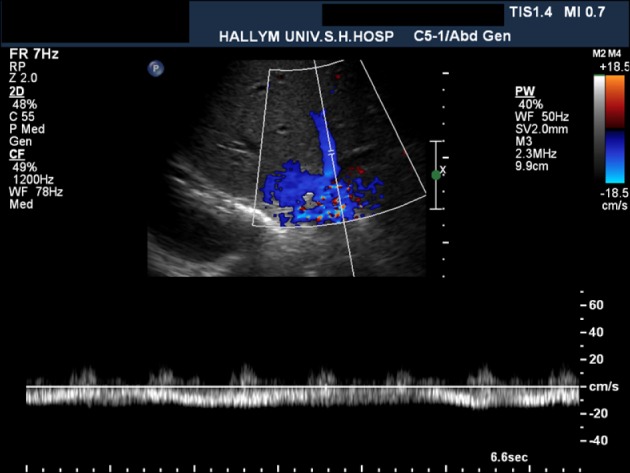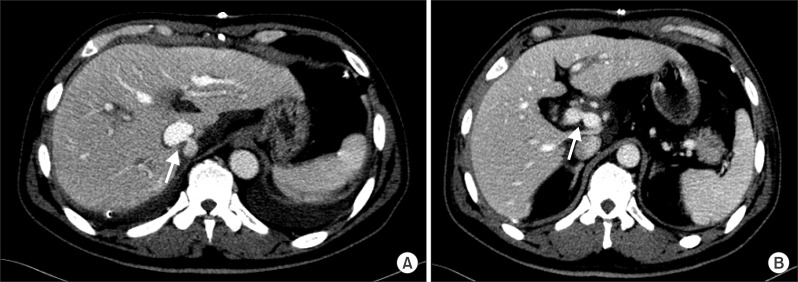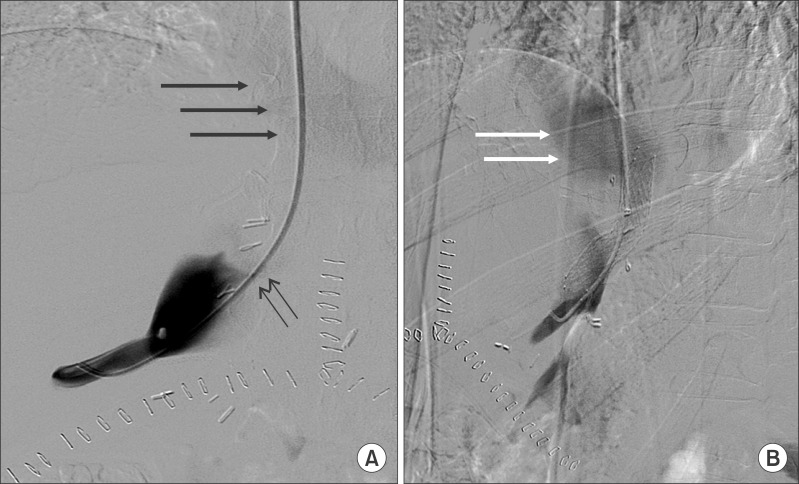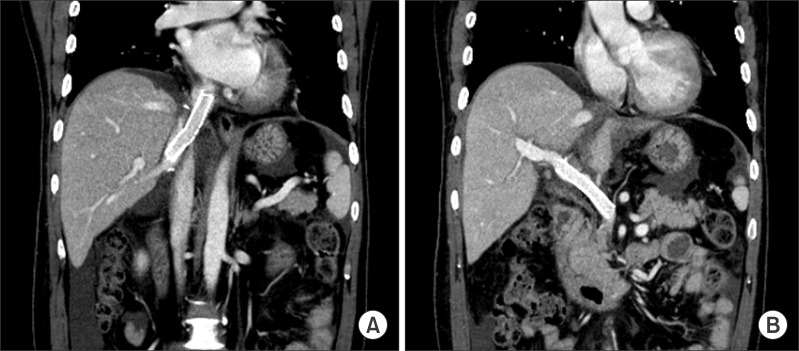Korean J Hepatobiliary Pancreat Surg.
2011 Aug;15(3):184-188. 10.14701/kjhbps.2011.15.3.184.
Cavo-caval intervention stent insertion after deceased-donor liver transplantation using side-to-side piggyback technique: report of a case
- Affiliations
-
- 1Department of Surgery, Hallym University Medical Center,Hallym University College of Medicine, Anyang, Korea. jjy1030@hallym.or.kr
- 2Department of Radiology, Hallym University Medical Center,Hallym University College of Medicine, Anyang, Korea.
- KMID: 2130991
- DOI: http://doi.org/10.14701/kjhbps.2011.15.3.184
Abstract
- Liver transplantation with preservation of the recipient vena cava (piggyback technique) has been performed as an alternative to the conventional method. Outflow disturbance or obstruction of the vena cava in the early period after liver transplantation is associated with high morbidity and mortality. We used side-to-side cavo-caval anastomosis (modified piggyback technique) in a deceased-donor liver transplantation (DDLT) for venous outflow reconstruction. On postoperative day 9, the patient developed abdominal discomfort, and abnormal liver function showing serum total bilirubin of 6.2 mg/dl and serum AST/ALT of 297/597 IU/L. Doppler ultrasound showed mono-phasic wave forms of the hepatic vein. Computed tomography showed focal narrowing of 9.5 mmx12 mm in diameter at the cavo-caval anastomosis site. Liver biopsy was showed that there was no evidence of acute allograft rejection. Direct venogram showed stenosis of the cavo-caval anastomosis with a pressure gradient of 12 mmHg. An interventional stent was inserted in the stenotic site of the inferior vena cava, and the pressure gradient decreased to 2 mmHg. He was discharged from hospital on postoperative day 23 without any other complications. Herein we report a case of deceased-donor liver transplantation using the modified piggyback technique, who received an inferior vena cava stent due to stricture of the reconstructed orifice of the vena cava.
MeSH Terms
Figure
Reference
-
1. Mehrabi A, Mood ZA, Fonouni H, et al. A single-center experience of 500 liver transplants using the modified piggyback technique by Belghiti. Liver Transpl. 2009; 15:466–474. PMID: 19399735.
Article2. Cescon M, Grazi GL, Varotti G, et al. Venous outflow reconstructions with the piggyback technique in liver transplantation: a single-center experience of 431 cases. Transpl Int. 2005; 18:318–325. PMID: 15730493.
Article3. Navarro F, Le Moine MC, Fabre JM, et al. Specific vascular complications of orthotopic liver transplantation with preservation of the retrohepatic vena cava: review of 1361 cases. Transplantation. 1999; 68:646–650. PMID: 10507483.
Article4. Ko GY, Sung KB, Yoon HK, et al. Early posttransplant hepatic venous outflow obstruction: Long-term efficacy of primary stent placement. Liver Transpl. 2008; 14:1505–1511. PMID: 18825710.
Article5. Lee SG, Park KM, Hwang S, et al. Modified right liver graft from a living donor to prevent congestion. Transplantation. 2002; 74:54–59. PMID: 12134099.6. Lee S, Park K, Hwang S, et al. Anterior segment congestion of a right liver lobe graft in living-donor liver transplantation and strategy to prevent congestion. J Hepatobiliary Pancreat Surg. 2003; 10:16–25. PMID: 12918453.
Article7. Tzakis A, Todo S, Starzl TE. Orthotopic liver transplantation with preservation of the inferior vena cava. Ann Surg. 1989; 210:649–652. PMID: 2818033.
Article8. Cherqui D, Lauzet JY, Rotman N, et al. Orthotopic liver transplantation with preservation of the caval and portal flows. Technique and results in 62 cases. Transplantation. 1994; 58:793–796. PMID: 7940712.
Article9. Bismuth H, Castaing D, Sherlock DJ. Liver transplantation by "face-à-face" venacavaplasty. Surgery. 1992; 111:151–155. PMID: 1736384.10. Belghiti J, Panis Y, Sauvanet A, Gayet B, Fékété F. A new technique of side to side caval anastomosis during orthotopic hepatic transplantation without inferior vena caval occlusion. Surg Gynecol Obstet. 1992; 175:270–272. PMID: 1514163.11. Kim JU, Wang HJ, Lee WH, et al. Clinical experience of side to side caval anastomosis during orthotopic liver transplantation without inferior vena caval occlusion. Korean J Hepatobiliary Pancreat Surg. 2001; 5:9–14.12. Mosimann F, Gillet M. Retransplantation of the liver after side-to-side caval anastomosis. Transpl Int. 1995; 8:157–158. PMID: 7766299.
Article13. Aucejo F, Winans C, Henderson JM, et al. Isolated right hepatic vein obstruction after piggyback liver transplantation. Liver Transpl. 2006; 12:808–812. PMID: 16628691.
Article14. Kim YJ, Ko GY, Yoon HK, Shin JH, Ko HK, Sung KB. Intraoperative stent placement in the portal vein during or after liver transplantation. Liver Transpl. 2007; 13:1145–1152. PMID: 17663391.
Article15. Belghiti J, Ettorre GM, Durand F, et al. Feasibility and limits of caval-flow preservation during liver transplantation. Liver Transpl. 2001; 7:983–987. PMID: 11699035.
Article16. Akilli B, Bayir A, Kara F, Ak A, Cander B. Inferior vena cava diameter as a marker of early hemorrhagic shock: a comparative study. Ulus Travma Acil Cerrahi Derg. 2010; 16:113–118. PMID: 20517763.17. May AG, Van de berg L, Deweese JA, Rob CG. Critical arterial stenosis. Surgery. 1963; 54:250–259. PMID: 13934073.
- Full Text Links
- Actions
-
Cited
- CITED
-
- Close
- Share
- Similar articles
-
- Late Hepatic Venous Outflow Obstruction Following Inferior Vena Cava Stenting in Patient with Deceased Donor Liver Transplantation Using Modified Piggyback Technique
- Comparison of three caval reconstruction techniques in orthotopic liver transplantation: result from a university hospital from Bangkok, Thailand
- Clinical Experience of Side to Side Caval Anastomosis during Orthotopic Liver Transplantation without Inferior Vena Caval Occlusion
- Left at right heterotopic implantation of left liver graft in adult-to-adult living donor liver transplantation: the technical concern for decision-making
- Side-to-side portal vein reconstruction for infant-to-infant deceased donor whole liver transplantation: Report of 2 cases with video





